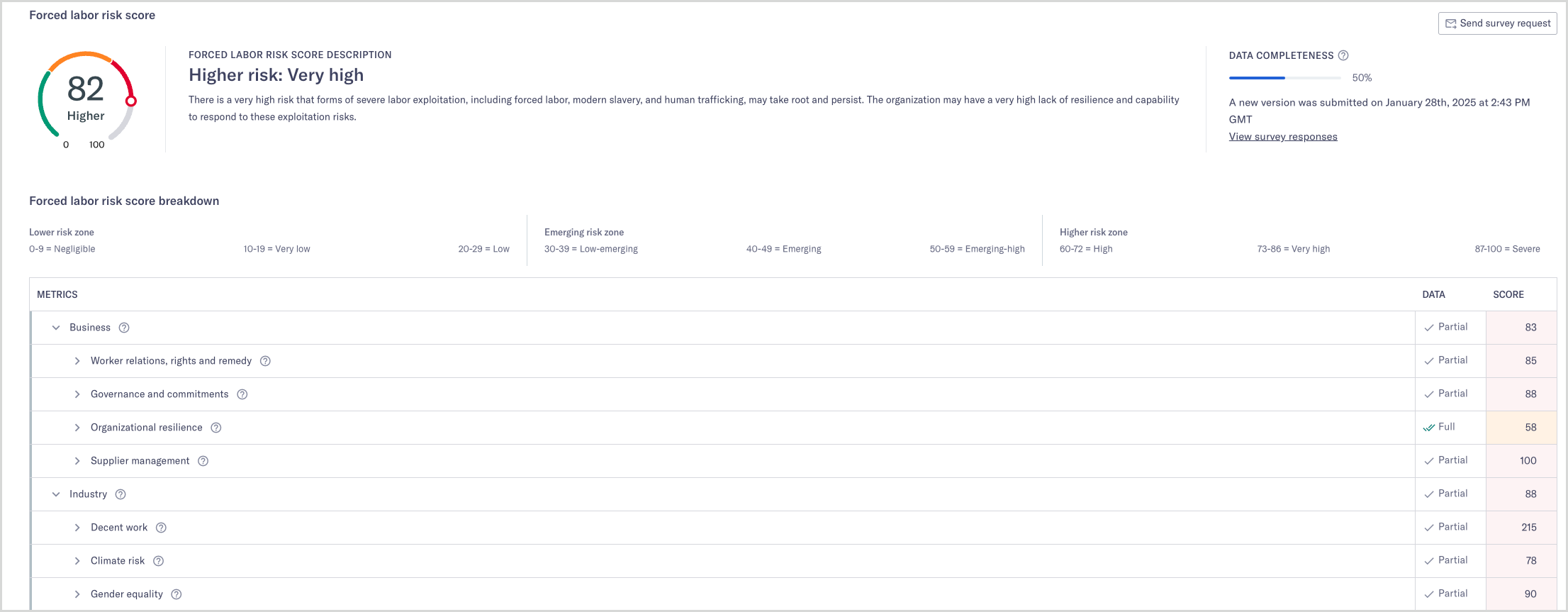Forced labor risk assessment check
The Forced labor risk assessment helps to uncover an organization’s risk exposure to all forms of forced labor and extreme labor exploitation using Moody's Forced Labor Risk Assessment. The Forced labor risk assessment check allows companies to assess, disclose, and manage risks comprehensively. The check also helps you to make efficient investments in risk mitigation strategies and systems and discharge compliance obligations. The check gives access to detailed due diligence through a multi-factor risk assessment, expert interpretation of risk, and guidance to take meaningful action. To learn more about the Forced labor risk assessment model, see Forced labor risk assessment model.
Information used to run this check
To run the check, the company entity information must have a valid Company number to generate the BvD ID, and all required fields must be filled.
The Forced labor risk assessment needs supplier survey data in order to give a Forced labor risk score. When running a check for a company for the first time, send a form to your supplier to fill out the questionnaire that helps form the score. Before sending the form, inform your supplier about the survey and ask them to provide an email address to which the form should be sent. To submit the form to your supplier, select in the Forced labor risk assessment. The form asks for the email address to be used before sending it.

Once the supplier has filled out the form, you can see their answers, the percentage of the form they completed, and the overall score. Any fields your supplier chooses to leave empty count negatively toward the overall score. The result of the Forced labor risk score is only available to your company and isn't visible to the supplier. If the supplier has an error or missing data in their submitted form, use the button to resend the form.
Overall results of the check
Moody's Forced Labor Risk Assessment generates a Forced labor risk score comprising three metric scores for Business, Industry, and Country risk. Each sub-score consists of categories that can be examined to see their weight relative to the overall score. The items listed first are the most weighted for the overall score. The Forced labor risk score and risk zones have scores from 0 to 100, with a higher score representing more risk. All scores are based on user input data. Missing data is penalized by assigning the corresponding metric the highest risk score.
The three metric scores are individually compared against the Maximum business score to pass, the Maximum industry score to pass, and the Maximum country score to pass, which are set in the smart policy. The comparison will return a Pass, Partial, Fail , or Error result. For a check to pass, the metric scores need to be lower or equal to the value set in your smart policy. Note that Moody's can't advise on the configuration of your maximum risk scores, which should be configured according to your own internal risk policy.
The scale categories of the risk score are the following:
Risk zones | Color | Risk sub-zones |
|---|---|---|
Lower risk | Green |
|
Emerging risk | Amber |
|
Higher risk | Red |
|
The overall score consists of three metric scores:
Metric scores | Risk categories and their metrics |
|---|---|
Business A range of financial characteristics of the organization, and an assessment of employee and supplier behaviors. The overall business score is a weighted sum of 10 individual metric scores. |
|
Industry Relate to an organization through its main industry/sector and the main industries associated with its primary suppliers and subsidiaries. |
|
Country Relate to an organization through the locations of the organization’s HQ and the locations of its primary suppliers and subsidiaries. |
|
Check results
These are the possible results of the check:
Result | Explanation |
|---|---|
Pass | The business, industry, and country scores are all equal to or below the provided threshold. |
Partial | Awaiting data. There is not enough data to generate a score. |
Fail | At least one of the business, industry, or country scores is greater than the provided threshold. |
Error |
|